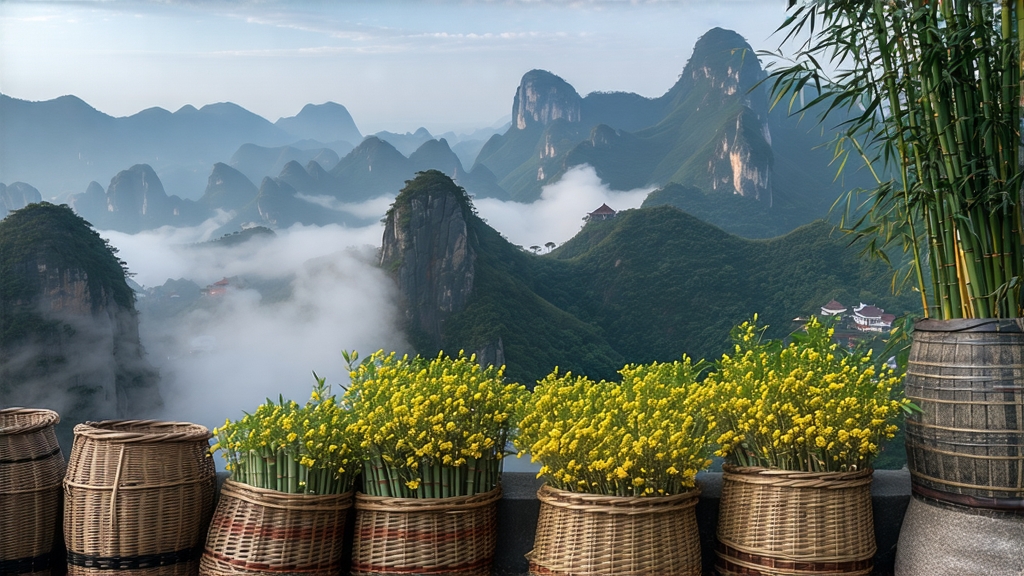
Tucked high in the mist-veiled Dabie Mountains of western Anhui Province, a tea once reserved for emperors still follows a calendar written in dew and mountain chill. Huoshan Huangya—literally “yellow bud from Huoshan”—is the least-known member of China’s six great tea families, yet it carries the most delicate secret in Chinese tea craft: the art of “menhuang,” a slow, breath-controlled smothering that turns green into gold. To drink it is to taste the color of late harvest moonlight, a flavor that disappears if you blink.
Historical whispers place Huoshan Huangya on the tribute lists of the Tang dynasty (618-907 CE), but solid court records begin in the Ming Wanli era (1573-1620) when county magistrates sealed the buds in waxed silk and rushed them by relay horse to Beijing. Legend claims the Wanli Emperor, restless with sweets, welcomed the tea’s orchid-sweet quietness and decreed the entire annual yield “forbidden to common lips.” By the late 19th century the cultivar had faded into farmhouse memory, saved only because a few Buddhist monks in the Zhongnan hermitage kept seed-trees in their cloister gardens. Rediscovery came in 1972, when a team of Anhui agronomists followed an 18th-century gazetteer up goat paths to find three ancient mother trees still clinging to a granite cliff. Cuttings from those survivors became the modern industry, now protected under China’s Geographic Indication law.
The tea belongs to the small-leaf Camellia sinensis var. sinensis, clone “Huoshan early bud,” distinguished by down so thick it looks hoarfrosted. Picking begins when each shoot reaches “one flag, one bullet”—the first leaf half-open like a pennant, the bud tight as a pellet. Pluckers work between 4:30 and 9:00 a.m. while dew still weighs the enzymes; any later, mountain updrafts wrinkle the leaf edge and ruin the smooth mouthfeel. A master will pick only 300 grams in a morning, the weight of a sparrow, yet that handful will shrink to 60 grams of finished tea.
Crafting Huoshan Huangya is choreography of heat and suffocation. First, the leaves are spread in bamboo trays under a thatched awning for six hours of withering, losing roughly 15 % moisture and the grassy bite of fresh catechins. The pivotal act follows: “sha-qing” or kill-green, but executed at a lower 140 °C for only three minutes, preserving a whisper of green so the later yellowing has something to transmute. While still warm, the leaf is piled in hip-high rattan baskets and wrapped with steamed cotton cloth; this begins menhuang, the “yellowing” unique to yellow teas. Every forty minutes the pile is fluffed and rewrapped, a ritual repeated through the night. Enzymes oxidize in near-anaerobic warmth, chlorophyll degrades into pheophytin, and flavonols polymerize into mellow, honeyed theaflavins. By dawn the leaf has turned the color of old parchment and exhales a scent like steamed pumpkin and narcissus. Finally the tea is baked over charcoal made from local chestnut wood, the fire so gentle a hand can hover above the wok for five seconds. Three rounds of baking—each followed by half-day rest—lock in the chestnut note and reduce moisture to 5 %. From field to finished lot, the process consumes seventy-two precise hours; miss one menhuang turn and the leaf slips into green tea territory, lose one baking hour and it drifts toward black.
The dry leaf is slim and straight, the color of antique ivory shot with green lightning. When rolled between fingers it crackles like thin rice paper, releasing an aroma that bridges sweet corn and alpine orchid. Brewed, the liquor is the clearest topaz, a color that seems to glow from inside the cup rather than reflect light. Aroma rises in strata: first the warm note of fresh chestnut, then a lift of lily, finally a cooling camphor echo that lingers in the sinus. On the palate it is all softness without flatness—umami like dashi made from mountain spring, a touch of raw almond, and a finish that Chinese tasters call “ginger breath,” a tingling coolness that starts behind the mol